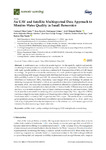Mostrar o rexistro simple do ítem
An UAV and Satellite Multispectral Data Approach to Monitor Water Quality in Small Reservoirs
| dc.contributor.author | Cillero Castro, Carmen | |
| dc.contributor.author | Domínguez Gómez, José Antonio | |
| dc.contributor.author | Delgado Martín, Jordi | |
| dc.contributor.author | Hinojo Sánchez, Boris Alejandro | |
| dc.contributor.author | Cereijo, Jose Luís | |
| dc.contributor.author | Cheda Tuya, Federico Andrés | |
| dc.contributor.author | Díaz-Varela, Ramón Alberto | |
| dc.date.accessioned | 2020-06-11T17:56:00Z | |
| dc.date.available | 2020-06-11T17:56:00Z | |
| dc.date.issued | 2020 | |
| dc.identifier.citation | Cillero Castro, C.; Domínguez Gómez, J.A.; Delgado Martín, J.; Hinojo Sánchez, B.A.; Cereijo Arango, J.L.; Cheda Tuya, F.A.; Díaz-Varela, R. An UAV and Satellite Multispectral Data Approach to Monitor Water Quality in Small Reservoirs. Remote Sens. 2020, 12, 1514. https://doi.org/10.3390/rs12091514 | es_ES |
| dc.identifier.uri | http://hdl.handle.net/2183/25697 | |
| dc.description | This article belongs to the Special Issue She Maps (https://www.mdpi.com/journal/remotesensing/special_issues/shemaps) | |
| dc.description.abstract | [Abstract] A multi-sensor and multi-scale monitoring tool for the spatially explicit and periodic monitoring of eutrophication in a small drinking water reservoir is presented. The tool was built with freely available satellite and in situ data combined with Unmanned Aerial Vehicle (UAV)-based technology. The goal is to evaluate the performance of a multi-platform approach for the trophic state monitoring with images obtained with MultiSpectral Sensors on board satellites Sentinel 2 (S2A and S2B), Landsat 8 (L8) and UAV. We assessed the performance of three different sensors (MultiSpectral Instrument (MSI), Operational Land Imager (OLI) and Rededge Micasense) for retrieving the pigment chlorophyll-a (chl-a), as a quantitative descriptor of phytoplankton biomass and trophic level. The study was conducted in a waterbody affected by cyanobacterial blooms, one of the most important eutrophication-derived risks for human health. Different empirical models and band indices were evaluated. Spectral band combinations using red and near-infrared (NIR) bands were the most suitable for retrieving chl-a concentration (especially 2 band algorithm (2BDA), the Surface Algal Bloom Index (SABI) and 3 band algorithm (3BDA)) even though blue and green bands were useful to classify UAV images into two chl-a ranges. The results show a moderately good agreement among the three sensors at different spatial resolutions (10 m., 30 m. and 8 cm.), indicating a high potential for the development of a multi-platform and multi-sensor approach for the eutrophication monitoring of small reservoirs. | es_ES |
| dc.description.sponsorship | This research was co-funded by the Spanish Ministry of Research, Innovation and Universities through the Torres Quevedo Sub-Program, grant number PTQ-15-07685 | es_ES |
| dc.description.uri | https://www.mdpi.com/journal/remotesensing/special_issues/shemaps | |
| dc.language.iso | eng | es_ES |
| dc.publisher | MDPI | es_ES |
| dc.relation | info:eu-repo/grantAgreement/MINECO/Plan Estatal de Investigación Científica y Técnica y de Innovación 2013-2016/PTQ-15-07685/ES/ | |
| dc.relation.uri | https://doi.org/10.3390/rs12091514 | es_ES |
| dc.rights | Atribución 4.0 Internacional | es_ES |
| dc.rights.uri | http://creativecommons.org/licenses/by/4.0/ | * |
| dc.subject | Satellite | es_ES |
| dc.subject | Water quality | es_ES |
| dc.subject | Multispectral imagery | es_ES |
| dc.subject | UAV | es_ES |
| dc.subject | Eutrophication | es_ES |
| dc.subject | Monitoring | es_ES |
| dc.title | An UAV and Satellite Multispectral Data Approach to Monitor Water Quality in Small Reservoirs | es_ES |
| dc.type | info:eu-repo/semantics/article | es_ES |
| dc.rights.access | info:eu-repo/semantics/openAccess | es_ES |
| UDC.journalTitle | Remote Sensing | es_ES |
| UDC.volume | 12 | es_ES |
| UDC.issue | 9 | es_ES |
| UDC.startPage | 1514 | es_ES |
| dc.identifier.doi | 10.3390/rs12091514 |






